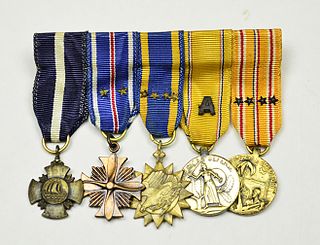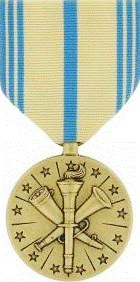
The Legion of Merit (LOM) is a military award of the United States Armed Forces that is given for exceptionally meritorious conduct in the performance of outstanding services and achievements. The decoration is issued to members of the eight uniformed services of the United States as well as to military and political figures of foreign governments.
The Commendation Medal is a mid-level United States military decoration presented for sustained acts of heroism or meritorious service. Each branch of the United States Armed Forces issues its own version of the Commendation Medal, with a fifth version existing for acts of joint military service performed under the Department of Defense.
The Navy "E" Ribbon or Battle Efficiency Ribbon was authorized on March 31, 1976, by Secretary of the Navy J. William Middendorf as a unit award for battle efficiency competition. The service ribbon replaced the "E" patch previously sewn on the right sleeve of the enlisted naval uniform for rates/pay grades E-1 through E-6.
The Antarctica Service Medal (ASM) was established by the United States Congress on July 7, 1960, under Public Law 600 of the 86th Congress. The medal was intended as a military award to replace several commemorative awards which had been issued for previous Antarctica expeditions from 1928 to 1941. With the creation of the Antarctica Service Medal, the following commemorative medals were declared obsolete;
A Sea Service Ribbon is an award of the United States Navy, U.S. Marine Corps, U.S. Coast Guard, the U.S. Army, and the NOAA Commissioned Officer Corps which recognizes those service members who have performed military duty while stationed on a United States Navy, Coast Guard, Army, or NOAA vessel at sea and/or members of the Navy, Marine Corps or Coast Guard who have been forward-deployed with their home unit.
The Air and Space Training Ribbon (ASTR) is the lowest military award of the United States Air Force and United States Space Force, ranking only above foreign military awards.
A "V" device is a metal 1⁄4-inch (6.4 mm) capital letter "V" with serifs which, when worn on certain decorations awarded by the United States Armed Forces, distinguishes a decoration awarded for combat valor or heroism from the same decoration being awarded for a member's actions under circumstances other than combat.

A 5⁄16 inch star (9.7mm) is a miniature gold or silver five-pointed star that is authorized by the United States Armed Forces as a ribbon device to denote subsequent awards for specific decorations of the Department of the Navy, Coast Guard, Public Health Service, and National Oceanic and Atmospheric Administration. A gold star indicates a second or subsequent decoration, while a silver star is worn in lieu of five gold stars.

The Good Conduct Medal is one of the oldest military awards of the United States Armed Forces. The U.S. Navy's variant of the Good Conduct Medal was established in 1869, the Marine Corps version in 1896, the Coast Guard version in 1923, the Army version in 1941, and the Air Force version in 1963; the Air Force Good Conduct Medal was temporarily discontinued from February 2006 to February 2009, followed by its subsequent reinstatement.

The Fleet Marine Force Combat Operation Insignia is a miniature 5⁄16 inch bronze United States Marine Corps emblem that may be authorized by the Secretary of the Navy for wear on specific campaign, expeditionary, and service medal ribbons issued to United States Navy sailors attached to and on duty with Fleet Marine Force (FMF) units during combat operations and sailors on duty with Navy units attached to and operating with Fleet Marine Force units while under Marine Corps operational control during combat operations. The device was instituted in 1953 with the Navy and Marine Corps Award Manual dated 1953.

A service stripe is an embroidered diagonal stripe worn on the sleeve(s) of some military and paramilitary uniforms. In the case of the United States military, service stripes are authorized for wear by enlisted personnel on the lower part of the sleeve of a uniform to denote length of service. Service stripes vary in size and in color.
The American Defense Service Medal was a military award of the United States Armed Forces, established by Executive Order 8808, by President Franklin D. Roosevelt, on June 28, 1941. The medal was intended to recognize those military service members who had served on active duty between September 8, 1939, and December 7, 1941.

The "A" Device is a miniature bronze 1⁄4 inch letter "A" which comes with and without serifs, that is authorized for wear by the United States Armed Forces as a medal and ribbon device for two military awards. It is added to overseas service ribbons to indicate the theatre of action.

The Armed Forces Reserve Medal (AFRM) is a service medal of the United States Armed Forces that has existed since 1950. The medal recognizes service performed by members of the reserve components and is awarded to both officers and enlisted personnel. The medal is considered a successor award to the Naval Reserve Medal and the Marine Corps Reserve Ribbon, which were discontinued in 1958 and 1967, respectively.
The Marine Corps Expeditionary Medal is a military award of the United States Marine Corps. It was established on 8 May 1919 as the Marine Corps Expeditionary Ribbon. A full-sized medal was authorized on 1 March 1921. The Marine Corps Expeditionary Medal is therefore one of the oldest medals of the United States military which is still issued to active duty personnel.
The Recruiting Service Ribbon is a military award of the United States Armed Forces which is issued by every branch of service. The United States Army previously only had the Army Recruiting Badge but this has since changed as of 2023 with the Army Recruiting Ribbon. The Recruiting Service Ribbon recognizes those military service members who have completed a successful tour as a military recruiter in one of the United States Military Recruiting Commands.

The Republic of Vietnam Civil Actions Medal also known as the Vietnam Civil Actions Medal or Civil Actions Medal, is a military decoration of the former South Vietnamese government (1955–75). The medal was created on May 12, 1964 during the Vietnam War. The Civil Actions Medal was awarded to the South Vietnamese military and its allies' military personnel or units that performed outstanding achievements in the field of civil affairs. The medal was awarded in two classes, with the first-class intended for commissioned officers and the second class for enlisted personnel. Individuals who were cited received the medal, ribbon, and a citation.

Insignias and badges of the United States Navy are military badges issued by the United States Department of the Navy to naval service members who achieve certain qualifications and accomplishments while serving on both active and reserve duty in the United States Navy. Most naval aviation insignia are also permitted for wear on uniforms of the United States Marine Corps.

The uniforms of the United States Navy include dress uniforms, daily service uniforms, working uniforms, and uniforms for special situations, which have varied throughout the history of the navy. For simplicity in this article, officers refers to both commissioned officers and warrant officers.

The National Oceanic and Atmospheric Administration Commissioned Officer Corps, one of the eight uniformed services of the United States, has the authority to issue various awards and commendations to its members. These include individual honor awards, unit honor awards, service awards, training ribbons and qualification insignia. NOAA Corps awards and decorations include:










